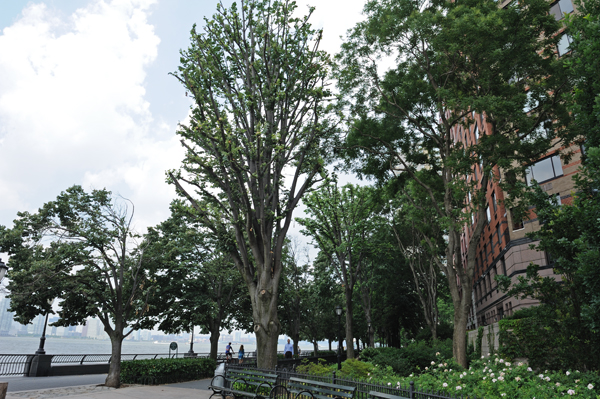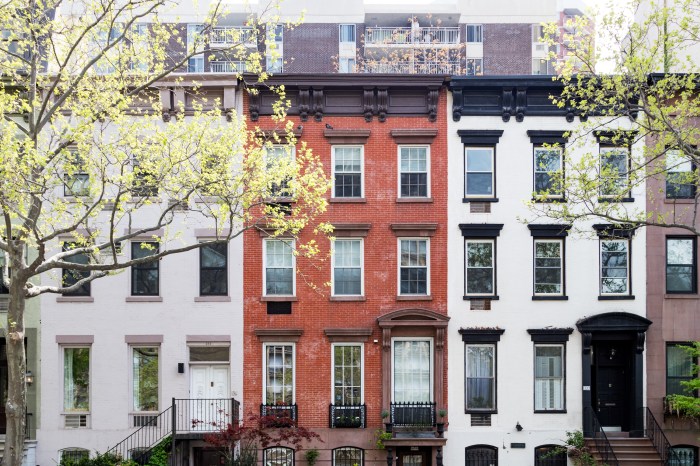
BY TERESE LOEB KREUZER | The trees on the Battery Park City esplanade between North and South Coves took a one-two punch this past year — first from Superstorm Sandy last October. Then weakened by Sandy, nine trees — seven lindens on the esplanade and two honey locusts on the Gateway Plaza property occupied by Merchants River House — were blown down by a violent storm on May 11.
The Battery Park City Parks Conservancy recently concluded that three trees have died as a result of Sandy and will have to be removed. In addition, it now appears likely that five more linden trees will have to come down because their root systems have been compromised and it would be unsafe to leave them standing.
The conservancy will soon hire an arborist affiliated with the American Society of Consulting Arborists to evaluate the situation.
“We want to get a formal report on the trees as well as recommendations on how we should prune trees moving forward to alleviate this sort of a risk in the future,” said Eric T. Fleisher, the conservancy’s horticulture director.
The conservancy will not be able to replace fallen trees until autumn at the earliest.
“Then,” said Fleisher, “if we are putting something back, we should reassess how they’re planted, where in the bed they’re planted and things like that. We’re looking at a different environment now than we were looking at 20 or 30 years ago.”
After Sandy, he said “we did everything we could to save the trees. We watered them non-stop for two weeks. We flushed the soil.”
About three-quarters of the parkland in Battery Park City was inundated with salt water, Fleisher added. The salinity levels immediately following the storm were more than six times higher than normal. These levels are measured in deciSiemens per meter, which describe the electrical conductivity of water. Enhanced conductivity indicates higher salt levels.
“Levels of .08 to .5 are acceptable,” he said. “We had levels of up to 3.60 deciSiemens per meter.”
Having done as much as it could, the conservancy’s horticultural department had to wait until spring and summer to see whether the treatment had been effective. The outlook worsened when the trees were assaulted by the May 11 storm or microburst, which narrowly targeted several blocks of the esplanade.
Immediately afterward, the conservancy removed most of the fallen trees. “We didn’t take them all away because there’s so much wood there,” said Fleisher.
He said the conservancy will contract with an independent firm to finish the job.
“We don’t have stump grinders and the kind of equipment that’s going to have to pull that stuff out,“ he said.
In the weeks following the microburst, the conservancy identified five linden trees whose roots had been so compromised by the storms that it was deemed prudent to trim the canopies.
“We could tell that the roots of these trees were compromised because we could see that the whole root system had lifted,” said Fleisher. “We had to take the weight off the tops of these trees because we couldn’t risk having them topple over.”
He would not say if the five damaged trees were the same ones the conservancy thinks are likely to come down, and said much more would be known after an arborist evaluates the trees.
The esplanade trees are around 35 years old.
“It’s difficult to say what the expected life would be in an urban environment,” he said. “You’re going to have less life expectancy of a tree in the city because it doesn’t have the same soil volume as it does in a natural landscape,” he explained.
But he also said that, “Roots don’t grow down. They grow horizontally. If you look at the roots of the trees that blew over, the roots are growing in the upper 24 inches of the soil. If they wanted to grow down, they could. There’s soil below.”
He thinks the trees fell over because of the storm damage and not because their root systems were inadequate for normal conditions.
In addition to some of the esplanade trees, two willow trees next to the Museum of Jewish Heritage and a dawn redwood (Metasequoia glyptostroboides) at the junction of the esplanade and Third Place (just north of South Cove) have died and will have to be removed.
The Metasequoia will be replaced with a Taxodium distichum, whose common name is “bald cypress” or “swamp cypress.” These trees are able to handle excess salt. Taxodium fossils from around 100 million years ago have been found in North America, indicating the hardiness of this species. They were alive during the time of the dinosaurs.
Battery Park City was not the only park to be affected by Sandy’s inundation. “At Brooklyn Bridge Park, they lost all their Metasequoias but none of their Taxodiums,” Fleisher observed.
Rebecca McMackin, director of horticulture for Brooklyn Bridge Park, has organized a consortium of waterfront parks to compare notes.
“We’re going to generate a plant list of those that were really affected by salt and those that weren’t,” said Fleisher. He said the trees were affected most.
At the consortium’s first meeting, the discussion revolved around how each of the parks responded to the crisis.
“Besides watering, some folks put gypsum down,” Fleisher said. “Gypsum is actually a salt itself but it will neutralize some of the salt effect in soils. We have done that here in relation to road salt in the past, but it’s not something that we like to do because it compromises the biology of the soil.”
In addition to Battery Park City and Brooklyn Bridge Park horticulturists, representatives from Hudson River Park, historic Battery Park and the parks on Governors Island attended. Horticulturists from the Rose Fitzgerald Kennedy Greenway Conservancy in Boston and the Boston Harbor Islands Parks participated by teleconference in the consortium’s first meeting.
“Although they weren’t affected, they very well could be affected in a future event,” said Fleisher, “so they’re benefiting from everything we’re talking about. It’s really a great thing. All these public parks are learning from the event.”
He said the conservancy will look to see what adjustments it might have to make now that storms are more violent and more frequent.


















